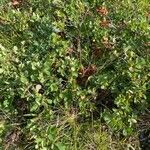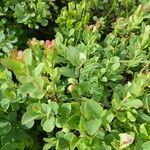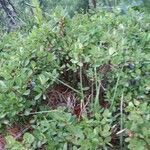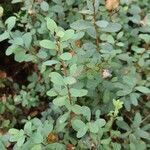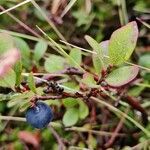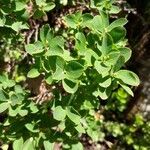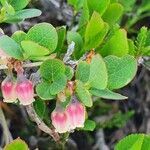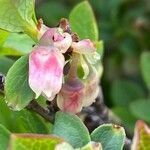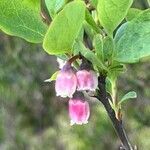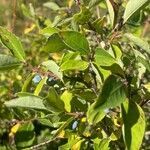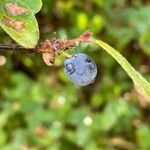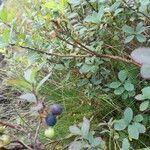Low, diffuse or matted, stoloniferous shrubs; lvs deciduous, firm, elliptic to oblong-obovate, blunt, entire; fls all or mostly 4-merous, in clusters of 1–4 from the axils of bud-scales, on pedicels 2–5 mm; sep ovate or triangular, 1 mm; cor pink, ovoid; anthers spurred; fr sweet, dark blue or black; x=12. Circumboreal, s. to n. N. Engl., n. N.Y., and n. Mich. June, July. Most of our plants belong to the circumboreal tetraploid var. alpinum Bigelow, often growing in bogs or muskeg, 1–3 dm, with lvs 10–25 mm and densely hairy on both sides, the frs 4–6 mm. (V. pubescens) In alpine sites we also have the diploid var. gaultherioides (Bigelow) Bigelow, occurring mainly from Greenl. and e. Can. to the high mts. of N. Engl., dwarf and tufted or matted, the glabrous or subglabrous lvs 5–10 mm and the fr 2–4 mm. (V. microphyllum)
Plants forming dense mats or open, extensive colonies; twigs of current season pale green, terete, glabrous or faintly puberulent, not verrucose. Leaf blades usually glaucous abaxially, green to glaucous adaxially, orbiculate, ovate, or obovate to narrowly elliptic, 8-14 × 3-7 mm, membranous, margins entire, surfaces often faintly puberulent, sometimes hairy throughout. Flowers: sepals usually distinct; corolla white to pink, 3-4(-5) mm, lobes 0.3-0.4 mm; filaments glabrous. Berries blue, 6-8 mm diam., glaucous. 2n = 24, 48, 72.
A small shrub. It has an open sprawling habit and forms loose mats. It grows 30-60 cm tall. It loses its leaves during the winter. The young branches are a yellowish-green and rounded. The leaves are 8-12 mm long and 3-8 mm wide. The leaves have prominent veins underneath. The leaves turn bright red in the autumn. The flowers are pale pink. They can occur singly or in clusters in the axils of leaves. The fruit are large, juicy purple/black berries. They are 5-12 mm across. They are edible.
